 |
|

|
 |
TABLE of CONTENTS
 |
First major storm of season tests MnDOT crews |
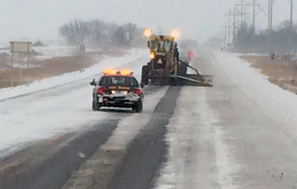
The State Patrol provides assistance for Tim Sand, Granite Falls Truck Station, in District 8 during a snow storm Nov. 10. Photo by Judy Jacobs |
The first major winter storm this season cut a wide swath across Minnesota Nov. 10, bringing with it up to 16.5 inches of wet snow and a brutal reality check: autumn is officially over.
MnDOT crews were out in force, pre-treating highways with salt in some areas to help keep roads drivable. Still, temperatures, precipitation and timing of the storm combined to make difficult driving conditions in many areas of the state.
“The heavy, wet snow made it slow going for the plow drivers,” said Jerimiah Moerke, District 4/Detroit Lakes public affairs coordinator.
The Minnesota State Patrol reported 475 crashes and more than 700 spin outs on the icy highways on Monday.
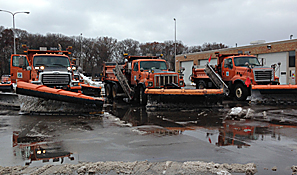
Snowplows at the Arden Hills Truck Station are prepared to finish cleanup after a snow storm Nov. 11. Photo by Kevin Gutknecht |
“Everybody forgets how to drive in it, and it’s like getting back to snow driving 101,” said Tim Nygren, a MnDOT plow operator from the Arden Hills truck station, who appeared on the ABC Evening News Nov. 11. Nygren took the reporter out in a snowplow and answered questions about his work over the last two days.
“What you plowed once that looked good, now it’s all covered again,” said Nygren, who said this was the worst storm he’s seen.
MnDOT’s www.511mn.org traveler information system got a workout during the storm, as well.
“The system was used quite heavily Monday, with more than 120,000 views by 10:30 a.m., then it bogged down for a period of time,” Kevin Gutknecht, Communications director, told KSTP-TV. “By the end of the day, we had more than 600,000 views on 511, which is a good sign that people are using the tool.”
On average, the system receives about 60,000 hits daily.
Nov. 10-14 is the national Winter Hazard Awareness Week. To help Minnesota residents minimize winter risks, check out the Minnesota Department of Public Safety’s website.
And for MnDOT’s tips on safe winter driving, see www.mndot.gov/workzone/.
|
 |
|

|
 |
TABLE of CONTENTS
 |
Changes to 511mn.org help users better understand winter road conditions |
By Sue Roe
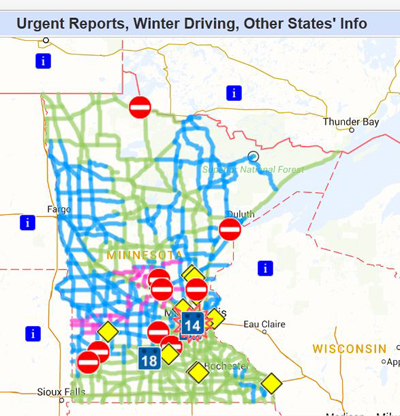
The new winter driving condition terms got their first test in this week’s first snowstorm. On the 511 website, the green means roads are normal. Blue means roads are partially covered and pink means roads are completely covered. Other new terms are travel not advised and closed, which will be shown on the map in purple and red. Graphic from 511 webiste |
The 511mn.org website and smartphone app now have better descriptions of what winter road conditions are throughout the state.
The old winter road descriptions were ‘good,’ ‘fair,’ ‘difficult’ and ‘hazardous/travel not advised.’ The new descriptions are ‘normal,’ ‘partially covered,’ ‘completely covered,’ ‘travel not advised’ and ‘closed.’
The changes were made because the descriptions were subjective and the public didn’t always understand or look at the meanings listed on the 511 website, according to Kelly Braunig, 511 coordinator.
“We were getting a fair amount of complaints,” she said. “An interpretation of good or fair might be completely different from person to person. We listened to our users and made improvements.”
Braunig looked at what area states used as descriptions for winter road conditions and adopted those from Iowa.
She worked with the Office of Customer Relations to try out the new terms. The survey, sent through the Online Customer Community, listed Minnesota’s descriptions and Iowa’s descriptions.
“The majority of the people surveyed, and our maintenance engineers, liked Iowa’s descriptions better, so we thought it would be a way to improve the 511 system,” Braunig said.
The changes are also part of Gov. Dayton’s administration-wide effort to implement “Plain Language” when communicating with Minnesotans.
“We think the public will have a better understanding of the terms now,” Braunig said. “It’s easier to understand that roads are ‘partially covered’ rather than ‘fair,’ or ‘completely covered’ instead of ‘difficult.’”
More details of each winter road condition description are available at http://hb.511mn.org/RoadConditions.htm.
“We encourage people to use other resources, such as radio, television and weather apps, to make decisions about traveling,” Braunig said. “We think everyone will appreciate these improvements to our 511 system.”
The 511 website was launched in 2001. During the 2013-2014 snow and ice season, there were more than three million views.
The free 511 mobile app launched in July 2013 and had 1.2 million views in the first year. On average, more than 2,000 people use the app each day. |
 |
|

|
 |
TABLE of CONTENTS
 |
State wraps up another year of road construction |
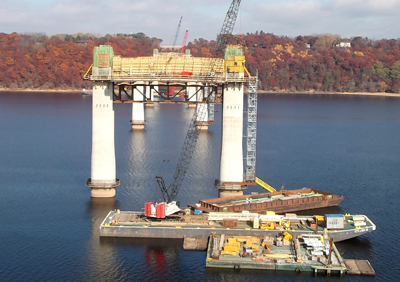
Work on the St. Croix Crossing continued in 2014, including on Hwy 36/Hwy 95 and frontage roads in Oak Park Heights and Stillwater. Bridge work included constructing pier columns at 12 of 13 pier locations, as well as crossbeam construction at three of five river pier locations. The bridge is expected to open in fall 2016. Photo by Elia Ayaz |
Major bridge construction, lane additions to existing highways and road resurfacing were part of the 308 projects underway during the 2014 road construction season.
“No doubt about it, 2014 was a busy construction year for the state,” said Commissioner Charlie Zelle. “These projects will help ensure that Minnesota’s transportation system is safe and reliable for years to come and demonstrate an effective use of tax dollars."
“I want to acknowledge the tremendous effort of MnDOT staff and contractor crews in delivering such a huge program this year, as well as the public’s cooperation and patience while traveling through construction zones. The progress we made this year would not have been possible without both.”
The $1.1 billion construction program included 74 projects in the Twin Cities and 194 projects in Greater Minnesota. An additional 40 projects helped improve safety at railroad crossings, and made improvements on runways and terminals at regional airports.
Projects in the Twin Cities include:
- I-494 rehabilitation between I-394 and the I-94/I-494/I-694 interchange – The shoulders on southbound I-494 are being reconstructed and widened. Crews widened the County Road 47, Schmidt Lake Road and Canadian Pacific Railway bridges to accommodate traffic changes to occur in 2015 and 2016. Project will be completed in 2016. (Construction cost: $86 million)
- Interstate 35E in St. Paul – Crews are reconstructing I-35E, adding a MnPASS Express Lane to provide more reliable commutes. Crews replaced the Arlington, Wheelock and Larpenteur Avenue bridges. The new Larpenteur Avenue Bridge was slid into place through an innovative, time-saving technology known as slide-in-bridge construction. The project is scheduled to be completed in 2015. (Construction cost in 2014: $32.8 million)
- Hwy 52/Lafayette Bridge – Construction continues on the new southbound bridge crossing the Mississippi River with a completion date of September 2015. The new northbound bridge is carrying both northbound and southbound traffic across the river. The anti-icing system is in place and will be operational this year on the northbound bridge. Rebuilding the two bridges one at a time saves motorists time and money by allowing traffic to use the existing bridge rather than detouring. (Construction cost in 2014: $15 million)
- Hwy 169 in Edina/Eden Prairie – Crews finished work on a major resurfacing and bridge deck repair project in late September. Work included the repair of 2.3 miles of concrete on Hwy 169 between Bren Road and Valley View Road. The project also included the reconstruction of both Hwy 169 bridge decks over Hwy 62. (Construction cost: $10 million)
Greater Minnesota projects include:
- Hwy 53 between Virginia and Cook – This project, which expanded 20 miles of Hwy 53 to four lanes, was completed in September and will improve safety and traffic flow. (Construction cost: $32 million)
- 15th Street Bridge in Bemidji – Crews replaced and raised the bridge deck, which will improve safety along the bypass, as well as clearance for large trucks. (Construction cost: $1.25 million)
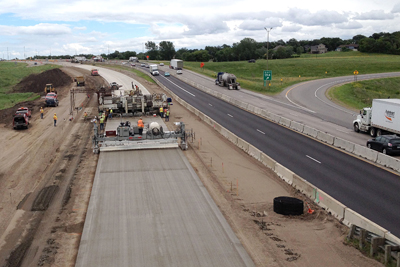
Crews completed reconstruction of two miles of I-94 in Monticello this summer. The $17.2 million project added an auxiliary lane along westbound I-94 between County Road 18 and Hwy 25, reconfigured the ramps and acceleration lane from Hwy 25 to eastbound I-94, upgraded signal systems and improved drainage. Photo courtesy of the I-94 Monticello project |
- I-94 between Rogers and St. Michael – Reconstruction of two miles of I-94 between Rogers and St. Michael will be complete in fall 2015. This two-year project will add lanes, improve the I-94 bridges spanning the Crow River and construct a noise barrier near high-density housing along westbound I-94. (Construction cost: $28.3 million)
- Hwy 10/County Road 2 interchange in Rice – Construction of a new interchange at Hwy 10/County Road 2 in Rice will be complete in November 2014. The two-year project replaces a crash-prone signalized intersection with a full interchange that uses a unique design that preserves local roadways while minimizing project costs. (Construction cost: $11.3 million)
- Hwy 29/Broadway in Alexandria – Crews replaced underground utilities, installed new sidewalks that meet Americans with Disabilities Act requirements, added several decorative elements and resurfaced the roadway. (Construction cost: $5.5 million)
- Hwy 10 bridge east of Glyndon – This project replaced the eastbound Hwy 10 bridge over the Buffalo River. The new bridge improves safety and helps preserve the Hwy 10 corridor between Moorhead and Detroit Lakes. (Construction cost: $1.2 million)
- Hwy 29 resurfacing and bridge replacements – Work is complete on the Hwy 29 resurfacing project between Benson and Hwy 40. Crews also replaced three bridges. The project used cold-in-place recycling, which is a longer-term fix than a traditional mill and overlay. (Construction cost: $6.5 million)
- Dresbach Bridge (I-90) – Significant progress was made on construction of the bridge piers. Two bridges will carry eastbound and westbound traffic, replacing the existing bridge when the work is complete in 2016. (Construction cost: $187.5 million)
- Winona Bridge (Hwy 43) – Work began in July to build a new bridge across the Mississippi River in Winona and then rehabilitate the existing historic bridge. Work will continue into winter to establish the bridge piers, so that impact from flooding will be minimized in the spring. Work is expected to be completed by 2019. (Construction cost: $142 million)
- I-35 Owatonna concrete reconstruction and bridge replacement – The two-year project is replacing four bridges and the concrete roadway in both directions of I-35. Work will resume in May 2015. (Construction cost: $19.1 million)
- Hwy 52 interchange at Cannon Falls – A new interchange was built in Cannon Falls and the final two traffic signals on Hwy 52 between Rochester and the Twin Cities were removed, along with adding access roads and repaving the highway through this zone. (Construction cost: $14.3 million)
- Hwy 60, Butterfield to St. James – Crews built two additional lanes for Hwy 60 to remove a gap in the four-lane system. This project, completed in October, will improve mobility and safety on an important commercial corridor from southwest Minnesota to the Twin Cities. (Construction cost: $14.2 million)
- Hwy 14 east of Owatonna – Approximately 2.5 miles of Hwy 14 east of Owatonna is being expanded from two lanes to four lanes. Construction for this Corridors of Commerce project started this summer and will wrap up in fall 2015. (Construction cost: $12 million)
- Hwy 52 and Goodhue County Road 9 interchange – Work is set to be completed in November on this quadrant interchange south of Cannon Falls. The work will improve safety by removing an at-grade intersection and carrying Goodhue County Road 9 traffic over Hwy 52 via an overpass. (Construction cost: $6.7 million)
- Hwy 169, St. Peter to Le Sueur – A flood mitigation project, which includes raising the grade and reconstructing two miles of flood-prone Hwy 169 and resurfacing nine miles of poor pavement, will be completed later this fall. (Construction cost: $11.6 million)
- Hwy 22 in Mankato – Crews built multi-lane roundabouts at two of the highest crash intersections in the area. MnDOT partnered with the city of Mankato and Blue Earth County on the construction to improve safety and decrease delays. (Construction cost: $7 million)
- Hwy 12 near the Highway 71 bypass in Willmar – Work is nearing completion on this one-mile reconstruction project on Hwy 12. The project includes constructing a right-turn lane and making Americans with Disabilities Act improvements. (Construction cost: $3 million)
For a complete list of 2014 projects and their status, see www.mndot.gov/roadwork/current.html; and for studies and plans for possible future projects, visit www.mndot.gov/roadwork/future.html.
|
 |
|

|
 |
TABLE of CONTENTS
 |
Indigenous Employee Resource Group celebrates National Native American Heritage Month |

November is National Native American Heritage Month. MnDOT’s Indigenous Employee Resource Group organized an event Nov. 5 at the Minnesota History Center in St. Paul to celebrate the rich and diverse cultures, traditions and histories, and to acknowledge the important contributions of Native people. In the photo on the left, Inyan Walking Elk, Indigenous ERG contact person, recognized the team that helped to plan and organize the event. In the photo on the right, from the left: Syd Beane, film producer and director, was moderator for a panel discussion that included Cheryl Secola, Minneapolis American Indian Center; Sisoka Duta, University of Minnesota; and John Poupart, American Indian Policy Center.
The panel discussed historical trauma and healing, language preservation and revitalization, and the evolution of Indian people in government.
Other speakers for the event included Commissioner Charlie Zelle; Sue Mulvihill, deputy commissioner and chief engineer; Ed Fairbanks, MnDOT tribal liaison; Jerry Dearly, St. Paul Public Schools Indian Education; Franky Jackson, Dakota historian; and D. Stephen Elliot, Minnesota Historical Society director.
Photos by Rich Kemp |
|
 |
|

|
 |
TABLE of CONTENTS
 |
Permitting section paves way for U.S. Capitol Christmas tree travels |
|
By Sue Roe

The U.S. Capitol Christmas tree made a stop at Peace Plaza in Rochester Nov. 7. Visitors could peek at the tree through windows in the back of the truck and also sign their name to a banner covering the side of the truck. Photo by Mike Dougherty |
The U.S. Capitol Christmas tree arrives in Washington, D.C., later this month and MnDOT’s oversize/overweight permits section helped get it there by issuing the permits required to travel the state.
The 88-foot white spruce came from the Chippewa National Forest in northern Minnesota courtesy of the Leech Lake Band of Ojibwe.
The tree, the first to come from the state in 22 years, was cut Oct. 29. It made 16 promotional stops in the state starting Nov. 2 on a 102-foot truck and flat trailer. Stops included Cass Lake, Bemidji, Walker, Blackduck, Grand Rapids, Duluth, West St. Paul, Eden Prairie, Rochester, and Owatonna. For a complete list of stops or to track its travels, go to the Capitol Christmas Tree website.
Debra Starr, senior permits technician in the Office of Freight and Commercial Vehicles, was in charge of issuing the 10 permits. One permit was issued for each day it traveled in Minnesota.
Starr was responsible for making sure the right information was entered into the online permitting system, including the routes. The tree had a police rear escort the entire way to help with turns.
“We tried to keep it on as wide a route as possible so it wouldn’t run into any trouble,” said Starr. “The hardest part was the long trailer because it doesn’t pivot.”
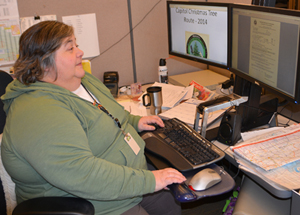
Debra Starr, senior permits technician in the Office of Freight and Commercial Vehicles, issued 10 permits so the U.S. Capitol Christmas tree could travel from northern Minnesota through the state on its way to Washington D.C. Photo by Sue Roe |
A computer routing system helped map the routes, but Starr decided on whether the truck and trailer needed special restrictions such as flaggers, police escorts and flashing amber lights. She also decided if any of the routes needed adjusted because of construction, bridge heights and power lines.
“All the requested routes were approved, except for Red Wing. Construction made us change that route,” Starr said.
The route in West St. Paul was challenging because of the streets it traveled on to get to its stop at an elementary school.
“This trailer is longer than usual, so we had to get a police escort for traffic control and to stop traffic if needed while the trailer maneuvers the turns,” Starr said.
Even though the tree permit is not a typical request, it’s not uncommon for the section to issue permits to transport large trees.
“Last year’s U.S. Capitol tree came from Washington State and it came through Minnesota,” Starr said. “We’ve had trees come through before, but we usually don’t do permits for so many stops in the state.”
More routine oversize and overweight loads the section issues permits for include wind turbines, steel beams, cranes, boats, houses, and farm equipment.
“We’ve done them all before,” Starr said. “But it’s neat that this tree came from our state and it’s the U.S. Capitol tree.”
The tree will travel more than 2,000 miles and make more than 30 stops through Minnesota, Wisconsin, Illinois, Michigan, Ohio and West Virginia before it gets to its final destination. It’s scheduled to arrive at Andrews Air Force Base Nov. 20 before heading on to U.S. Capitol. The lighting ceremony will take place Dec. 2. |
 |
|

|
 |
TABLE of CONTENTS
 |
New Linear Referencing System will be implemented in early 2015 |
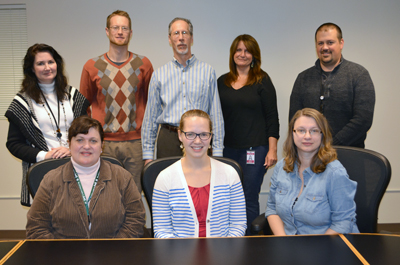
Members of the Linear Referencing System project included: (first row from left) Jocelyn Stein, Office of Transportation System Management; Amelia Rockwood, OTSM; Christy Prentice; OTSM; (back row from left) Suzanne Cellette, MN.IT; Jesse Pearson, OTSM; John Wilm, OTSM; Jackie Weldon, MN.IT; and Scott Patnode, MN.IT. Photo by Rich Kemp |
A project team from Transportation System Management and MN.IT @ DOT is working to modernize the Transportation Information System and retire the 40-year old legacy mainframe. The team is implementing the Linear Referencing System as the main source for planning-level location data. The system will eventually be integrated with other MnDOT applications and systems.
The LRS is part of a larger umbrella of systems to replace the Transportation Information System. The new LRS will be implemented in early 2015.
“It is exciting to be so close to implementing this new, more user-friendly system,” said Jocelyn Stein, strategic initiatives project director. “The project team has worked very hard during all phases of the project, and has a strong commitment to delivering a quality product.”
Benefits of the LRS include:
- A centralized tool for locating and analyzing spatial roadway data attributes
- A tool to translate between various linear referencing methods
- The ability to track history from the time of the system’s implementation
- A precursor for Shared Centerline collaboration with local jurisdictions
- Improved tools for data quality and business process workflows
In early 2014, the project team began to survey and meet with applications that use TIS/LRS data.
The project team has been assessing whether or not any affected systems or applications were missed. If any were missed, the project team will assess the changes the system or application may need to make to continue using data formerly available in the TIS mainframe.
Employees who work with a system or application that could be impacted by the LRS implementation and have not been in contact with the LRS project team should contact Stein.
|
| |
|

|
 |
TABLE of CONTENTS
 |
How to create accessible emails |
By Becky Niyukuri
To help ensure your emails are accessible to everyone, including folks who use a screen reader or other assistive device, or those who use smart phones and tablets, here are a few things to keep in mind as you’re typing your next email.
Use a short and sweet subject line, and summarize attachment information in the body of your email
Ever tried to open an attachment on your smartphone only to get frustrated when it took forever to download? Or opened an email at your desk that had a vague subject line or an attachment with a vague title? Save your audience some time and guesswork by pulling any important content out of the attachment and into the body of your email – the basic who, what, when, where and why. You can still attach a file for reference or for distribution purposes, but that way people don’t have to click to access the information before they even know what they’re opening. Remember, too, that email attachments aren’t always accessible to folks using assistive technology, so this method will ensure they can access the content and save everyone some valuable time and energy.
Choose a font that’s easy to read
The same goes for font colors and email backgrounds; the goal is to make your email easily readable with plenty of contrast between font color and background color. Probably the best option is no background color at all. Not that your creativity should be limited, but keep in mind particular style combinations might not be appreciated or fully accessible by folks with visual impairments like color blindness.
Add basic structure/formatting as needed
If you are typing an email that’s suddenly turning into a lengthy novel, go through and reread to delete any unnecessary text. You can even add headers for easy skimming. Or better yet, imagine the audience you’re sending it to and highlight the important points for them in bullet format or under a separate header, such as “action items,” so people don’t have to sift through all of the content to prioritize the work.
For more on accessible communication, visit http://ihub/communications/adaweb.html.
|
 |
|

|
|
| |
|



